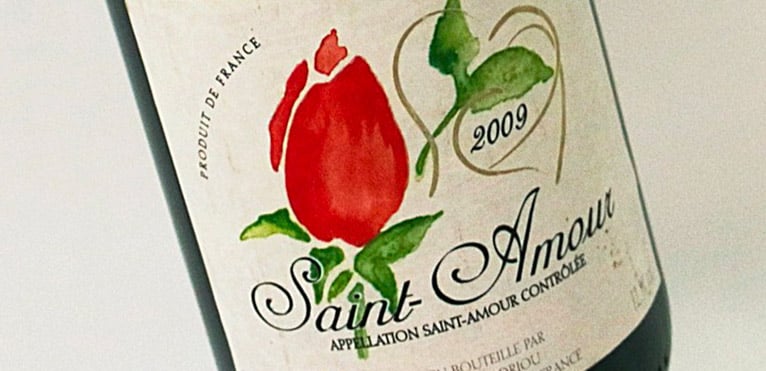
Contents
The Saint-Amour appellation extends over the commune of Saint-Amour-Bellevue in the Beaujolais region. Since the 1946 decree, this appellation has been recognized as an appellation d’origine contrôlée (AOC).
The Beaujolais region lies north of Lyon and boasts 12 appellations, including Saint-Amour. Only red wines are produced under this appellation. Saint-Amour wines can be divided into two styles, depending on the winemaking method used: light, fruity wines, and spicier, full-bodied wines. However, Saint-Amour is still characterized by its elegance.
The Saint-Amour appellation competes with Cupid
Saint-Amour owes its name to the Roman soldier Amor, who took refuge in this Gallic territory to escape a massacre in the Swiss Valais. When he became a Christian missionary, he gave his name to the village.
Saint-Amour is celebrated on August 9, and is an occasion to celebrate love in its many forms: passion, feelings of love, family and friends.
The cult of Saint Amour is said to have been established in the commune by the Church as an alternative to the worship of the ancient Roman god Cupid. The story of the Amor soldier could therefore only be a legend invented by the Church to win back the faith of pagans.
The appellation is one of the ten crus of the Beaujolais vineyards. Other appellations included among the crus are: Brouilly, Chiroubles, Chénas, Côte-de-Brouilly, Fleurie, Juliénas, Morgon, Moulin-à-vent and Régnié.
The Saint-Amour AOC benefits from numerous and varied terroirs
Saint-Amour is located at the northern end of the Beaujolais vineyards, some twenty kilometers south of Mâcon, and its vines cover the commune of Saint-Amour-Bellevue, a village that exudes winegrowing authenticity.
Its hillsides, at altitudes ranging from 250 to 470 meters, benefit from generous sunshine.
The appellation covers some 320 hectares of vines, or around 2% of the total area of the Beaujolais vineyards to which it belongs. The appellation is the second smallest cru in the vineyard, but boasts the widest variety of terroirs, with 17 according to the soil map.
These terroirs are mainly clayey-siliceous and granitic, with schistose layers. The vines benefit from a semi-continental climate with some Mediterranean influences. The climate is temperate and rarely cold, which helps the vines to flourish.
The vineyard density in this appellation exceeds 6,000 vines per hectare, with an average yield of 48 hectolitres per hectare.
Saint-Amour wines have silky tannins and notes of black fruit.
One grape variety predominates, accounting for 85% of the appellation’s specifications. This is the Gamay Noir with white juice, which has an unfortunate tendency to run out, as it is reputed to be weak, but is fertile. Winegrowers are also allowed to use Aligoté B, Chardonnay B and Melon B, but in much smaller quantities.
Saint-Amour wines are brilliantly colored, always with dark garnet highlights. Over time, it tends towards the intense ruby with violet highlights.
Nose, aromas of apricot and peach.. They go well with red fruit like blackcurrant or raspberry. Then.., after two or three years, the aromas become spicier.
These are wines with silky tannins that express lightness and delicacy. And indeed, on the palate, the attack is supple, revealing lovely floral notes.
Saint-Amour wine has a fleshy, concentrated texture and an aromatic bouquet expressing notes of black fruits such as blackcurrant and blackberry. It has an ageing potential of between 2 and 5 years in the cellar.
Saint-Amour goes equally well with meats and pizzas.
They go particularly well with pork filet mignon, game birds, guinea fowl with orange sauce, or even a good pizza.
They are also reputed to go wonderfully well with red meat.
The ideal tasting temperature is between 12 and 14 degrees.
Many great vintages for Saint-Amour
Saint-Amour is distinguished by several vintages that confirm the quality of the wines from this appellation. Indeed, it can look back on the vintages of the century that were decreed in 1945, 1949, 1952 and 1959, but above all on several vintages of the millennium, the latest of which dates from 2011!
2 Saint-Amour estates with ancestral viticultural techniques
Domaine de la Pirolette
The Domaine de la Pirolette is perched at the top of the hill opposite the village church of Saint-Amour. This is one of Saint-Amour’s largest winegrowing estates, ideally situated on the appellation’s best terroirs. The latter was taken over in 2013 by Grégory and Virginie Barbet.
Château de Lavernette
Château de Lavernette has been owned by the Lavernette family since 1596. Today, the Lavernette descendants, the de Boissieu family, are the heirs to this beautiful property. Located in the communes of Leynes and Chaintré, the château forms part of the border between the Beaujolais and Mâconnais regions. The owners decided to cultivate their vines biodynamically and organically, obtaining AB certification in 2005 and Demeter certification in 2010.